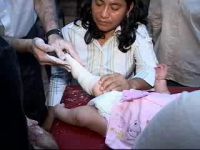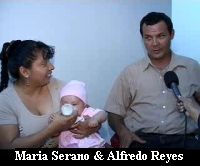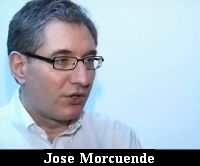
The birth defect called club foot – doesn’t get much attention;
it’s widely viewed as just one more unfortunate, crippling condition.
But it is treatable, eminently so. But up until now, in Belize unless a family
had the financial means to get the care needed for their disabled child which
mostly required travelling abroad for treatment many patients go through life
doing the best they can with a condition that left them dependent and demoralized.
Today however medical history was recorded when a procedure developed
fifty years ago was made available in Belize. It will be provided through a
national programme was formally launched today. Today I spent most of the morning
with one special child who became one of the first Belizean patients to receive
the specialized care and as I found out it is not only the very young who stand
to benefit.
Jacqueline Godwin
Reporting
Four and half month old Mary Reyes looks like a normal healthy infant but for
her parents Maria Serano and Alfredo Reyes she is their miracle baby. Since
little Mary was born on September tenth 2008 she has had two surgeries for spina
bifida and what is locally referred to as water head. When her mother Maria  Serrano was in her third trimester the doctors noticed that the baby’s
feet were deformed.
Serrano was in her third trimester the doctors noticed that the baby’s
feet were deformed.
Maria Serano, Mother
“Of course I was frightened because I didn’t know what to do,
what would be the outcome. Hmm, I started to cry.”
Maria was told that her daughter had congenital clubfoot, the most common birth
defect of human bones and joints
Alfredo Reyes, Father
“She wants to live and she is very energetic.”
Jacqueline Godwin,
But she must bring so much joy in both of your lives.
Alfredo Reyes,
“As old as I am, this is my first child. I didn’t rush anything
in life. I found someone and she gave me a beautiful baby girl.”
It is estimated that more than eleven children are born with clubfeet in Belize
every year. Many grow up without receiving medical care and are left unable
to stand or walk. But today thanks to a signing agreement between International
Hospital for Children and Belize’s Ministry of Health young patients like
Mary Reyes will now be able to receive a non surgical treatment known as the
ponseti method.
Dr. Peter Allen, CEO - Ministry of Health
“Kids who otherwise really wouldn’t be able to walk or play
football or climb a tree with the rest of the kids, within a very short time
can live a perfectly normal life and be playing football for Belize against
Honduras and next time we will win.”
Today baby Reyes was one of five Belizean children who were ”casted,”
the first stage in a series of treatments to improve the function of her limbs.
Jose Morcuende, Associate Professor - University of Iowa City
“The foot is usually very stiff and what it requires is a very gentle
manipulation stretching of the ligaments and tendons of the foot and then you
do casting in order to keep the foot stretched. Usually it takes about five  to seven casts to get the foot corrected. You can change the cast every four
to seven days and so at the end of a month, month and a half, the foot is fully
corrected and normally positioned like a normal foot.”
to seven casts to get the foot corrected. You can change the cast every four
to seven days and so at the end of a month, month and a half, the foot is fully
corrected and normally positioned like a normal foot.”
Once Mary’s final cast is removed she will then need to wear special
shoes to prevent any reoccurrence of clubfoot. Jose Morcuende is an Associate
Professor at the University of Iowa where the ponseti method has been used for
fifty years.
Jose Morcuende,
“It can come back and in order to prevent that from happening, a very
simple device is used and the device is just a pair of shoes with a bar or a
wood in between the shoes to keep the foot opened. When the patient is asleep,
not during because during the day the child is walking and the muscle is properly
working.”
The treatment is painless as you can see while being casted little Mary not
only drank her bottle of milk but slept soundly through most of the procedure
Maria Serano,
“I am very happy, I am very glad that at least there is somewhere
you can go for help and get assistance from the people.”
Alfredo Reyes,
“From the time the baby was born, she had a few medical problems.
The two serious medical problems were corrected and the only thing left is her
little feet to be corrected.”
Hannah Cockrell, Student Intern - Int’l Children’s Hospital
“With the help of CARE and the Ministry of Health there have been
so many people who’ve been working really hard to put this together for
the last three months and it is just really rewarding to be here today and to
see the first five children be casted and to know we are going to be able to
give them normal feet so they’ll be able to run and play with other children
their age.”
Jose Morcuende,
“You can do this not just for the newborn, you can actually do any
age until about ten or fifteen years of age.”
Jacqueline Godwin,
That’s amazing because you think the older the patient the more set the
bone is.
Jose Morcuende,
“Yes they are and it takes a bit longer. In an older kid like 3 or
4 years of age or five years, it takes about three months to get the foot corrected.
But the results are the same and so it is really a life changing method. It
is very low cast, it only takes the cast, you don’t x-rays and you don’t
need surgery.”
The ponseti method is well suited for countries like Belize where medical resources
are limited but now a national programme is available to all children in need
of the treatment.
Dr. Peter Allen,
“And make sure that them kids who have birth defects of any kind,
including Clubfoot Syndrome are referred to, in this case CARE Belize or the
International Hospital for Children. We can make sure that they have access
to the best possible care and in this case the ponseti method.”
Alfredo Reyes,
“Until you have a kid, you know what it is and when you can’t
do something, and these people come like you said like angels and then they
help you.”
While most children’s club feet straighten in five to six weeks followed
by the use of braces Mary Reyes’ case is bit more complicated due to the
spina bifida.
And so her ability to walk will depend on the severity of that spina
bifida. Orthopaedic Surgeon Idelfonso Roberts who works at the Karl Heusner
Memorial Hospital is one of the three medical professionals in Belize who have
been trained to perform the ponseti method. Dr. Roberts has also been trained
to teach others to do the procedure.



